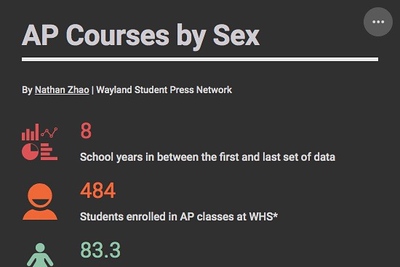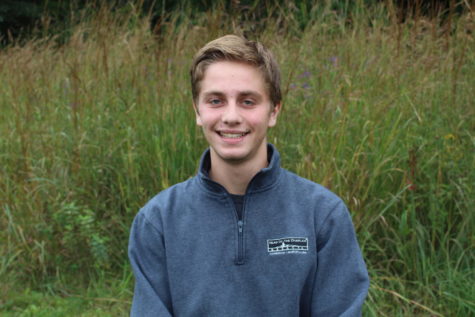Examining the gender gaps in AP courses

Pictured above is an infogram representing the results of WSPN’s survey of the genders of AP students. “Through our socialization, we tend to draw boys toward science and math and girls toward language and reading,” Spanish teacher Jill Swenson said in 2014.
April 25, 2019
In the workforce, STEM-related fields, including computer programming, scientific research, and engineering, are male-dominated. According to official school data, AP enrollment at WHS follows this trend, with more females enrolled in AP humanities courses and more males enrolled in AP STEM courses.
While five out of eight STEM AP classes have a male majority, there are a few, such as AP Biology, that have more females. Science teacher Cyd Tyska attributes this discrepancy to the qualitative nature of biology.
“I think in general because AP Biology is more qualitative than quantitative, it may cause the gap,” Tyska said.
Of the three AP Science classes, both AP Chemistry and AP Biology have a female majority. AP Physics is the only science with a male majority.
“I always wonder why AP Physics [has a gap] at a school like this,” Tyska said. “I always think of Wayland being different. We have very strong female students with strong role models as parents, a lot of female doctors, scientists and engineers.”
Another AP class that tends to have a greater male majority is AP Computer Science A. Computer science teacher Michael Hopps, who has been teaching at Wayland for 16 years, has consistently seen a 75-85% male majority in his classes.
“15 years ago it was definitely more skewed to the male side,” Hopps said. “More like an eighth of the classes would be female. Back then I had seven, ten, twelve kids a year taking the class and now we’re up to 65, so as those numbers have grown, and the class has become more of a mainstream class, we’ve gotten more girls into the course which is great, and we’ve kind of leveled off around that 25% number.”
Although the gap is a common problem throughout Wayland’s AP classes, Hopps doesn’t think that WHS is alone in this issue.
“You’ll find that right now a lot of companies want to diversify the workforce to get different perspectives and different ideas and different life stories and backgrounds into the work environment so they can have new ideas and innovation,” Hopps said. “It turns out it’s tough. It’s not just us, it’s other high schools, other universities.”
Hopps attributes the drastic difference between girls and guys in computer science to societal pressures.
“I’m not sure what it is about computer science, whether it’s a perception that computer programming is somehow tied into video gaming and that video gaming is more heavily male than female,” Hopps said. “There’s that connection that could somehow skew those numbers.”
Hopps hopes to level out class composition by introducing a wider variety of introductory computer science classes, such as AP Computer Science Principles.
“I’ve definitely had a number of girls this year who took [introductory] courses last year,” Hopps said. “Also, the [AP CS] Principles course is helping things as well. Ms. Kooshan’s classes are closer to a 50/50 split and a number of her students will take AP CS A with me next year. Those other courses are feeding into [AP CS A and] leveling things out.”
Junior Jenna Cook is interested in pursuing a STEM-related career. Cook wants to fight for more equality within those fields, as they are currently extremely male-dominated.
“Nowadays more women are becoming more involved in STEM, and I think it’s really important,” Cook said. “It’s something that I’d want to be a part of because it’s a male-dominated field and a lot of women are turned away from classes like physics and hard math courses or hard science courses because they are seen as not able to do it. I feel like it also plays a part in going against what society expects for women. Having more women involved in science and math and engineering projects will make for a more equal world. There are tons of women that are in STEM that have done amazing things.”
Although the real world may be discriminatory towards women in STEM, Cook acknowledges that girls at WHS are encouraged by teachers to take challenging courses, just like boys.
“[I have a friend whose] physics class is all boys except for four girls and often the girls in the class will get remarks like ‘you shouldn’t be in physics,’ or ‘you don’t know what you’re doing,’ and this shocks her teacher, and she is really upset that the girls are being treated that way just because they are girls in physics,” Cook said.





![Last Wednesday, the Wayland School Committee gathered to discuss a number of topics regarding the health curriculum and Innovation Career Pathway course. Another large topic of conversation was the ways to potentially mitigate distracting cell phone usage. "These [phones] are going to distract your learning and social relationships," Superintendent David Fleishman said. "That's concrete right there."](https://waylandstudentpress.com/wp-content/uploads/2025/06/Screenshot-2025-06-04-at-9.49.31 PM-1200x886.png)



























![Troy Hoyt finishes the Boston Marathon, running for the Hoyt Foundation. T. Hoyt is the son of Hoyt Foundation CEO Russ Hoyt.
“[Running a marathon] might seem like a big thing, when it’s presented to you at first, but if you break it up and just keep telling yourself, “Yes, you can,” you can start chipping away at it. And before you know it, you’ll be running the whole 26 miles, and you won’t even think twice about it.” T. Hoyt said.](https://waylandstudentpress.com/wp-content/uploads/2025/04/C36E8761-1CBB-452E-9DF2-543EF7B1095E_1_105_c.jpeg)













































Delaney • Apr 25, 2019 at 7:48 PM
Excellent reporting!
g e i • Apr 25, 2019 at 5:33 PM
Thank you Alex!!! Very Cool!!!!